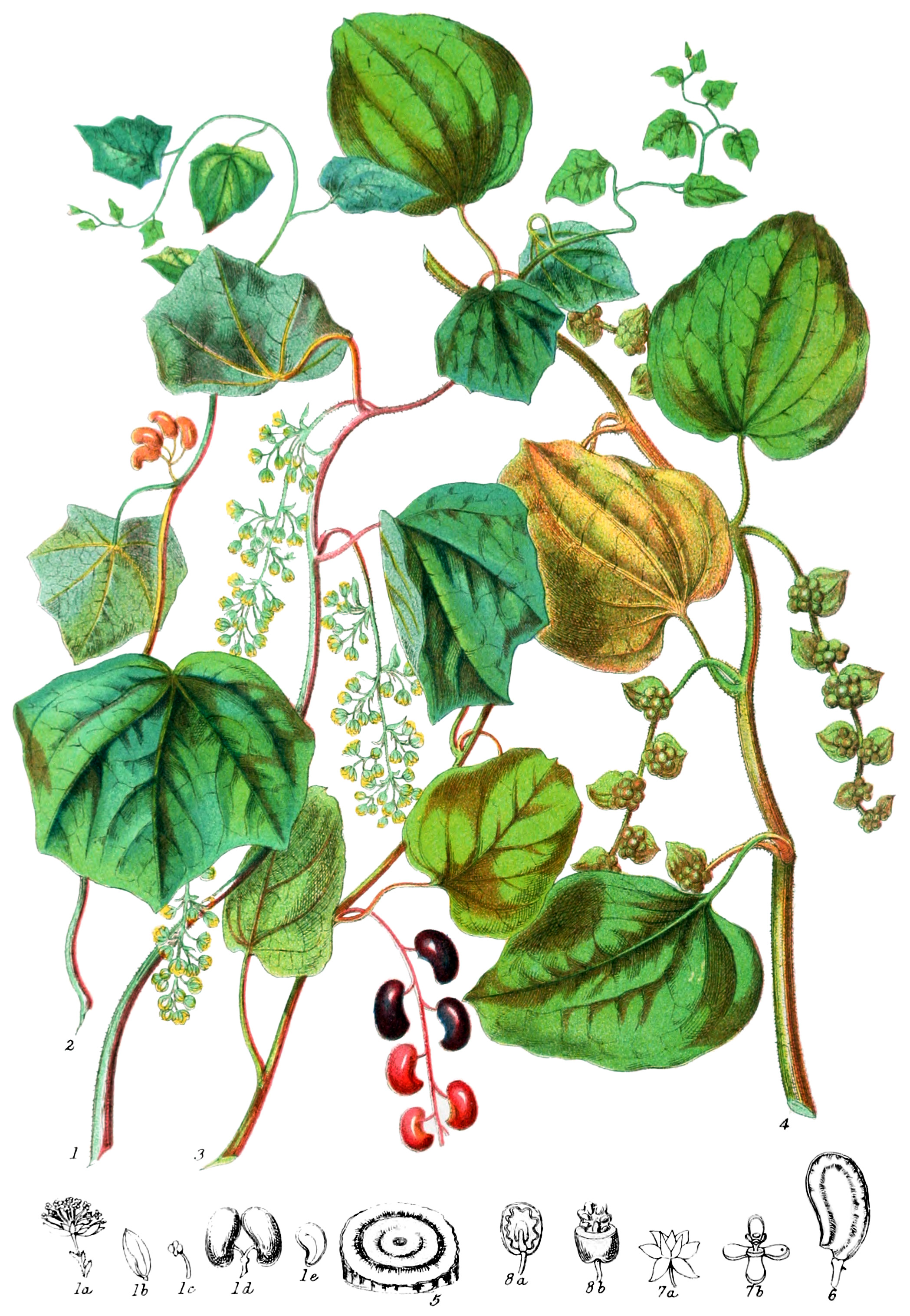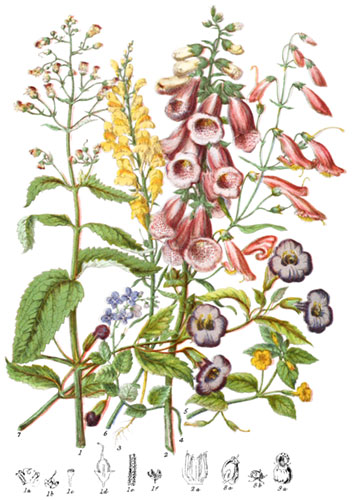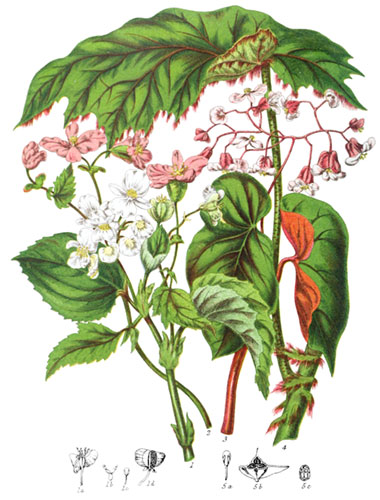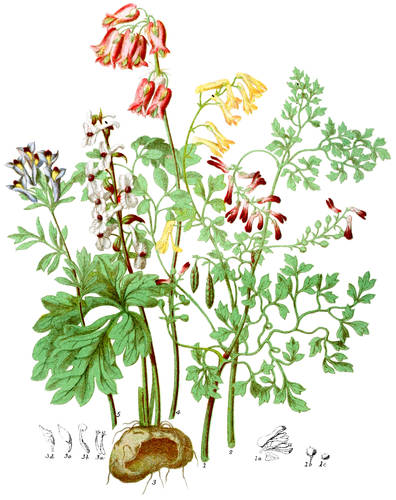Key characteristics
This Order consists of shrubs and perennial herbs, of a flexible, touch nature, and climbing habit; the wood is frequently without concentric zones. The leaves are alternate, usually simple and entire, sometimes peltate or buckler-shaped, in some instances compound, destitute of stipules. The flowers are small, usually on slender branching stalks, having stamens and pistils on separate plants; the sepals and petals of the stamen flowers are nearly alike in appearance, placed in rows of three or four, seldom five, falling off soon. The stamens are unite in a set, or occasionally distinct, sometimes opposite the petals, and equal to them in number, sometimes three or four times as many; the anthers are turned outwards, fixed either along the edge of the filament or at its point. The pistil-bearing flower has occasionally only one sepal and one petal on one side of the pistil. The style is simple or trifid. The seed-vessel is usually an oblique or moon-shaped berry, compressed, bearing one seed, usually attaining the same crescent form; the albumen, when present, is thin and fleshy, or horny.
Allied with Kadsura in the Custard-apple tribe; the yellow wood and bark and the bitter taste connect it with the Berberry.
Active narcotic and bitter qualities prevail among these plants: the narcotic principle is in some species so abundant as to render them poisonous; the bitter properties of some cause them to be valuable as tonic medicine: a few species are mucilaginous.
Menispermum, Moon-seed, was named from the Greek, in allusion to the crescent form of the seed-vessel.
Select plants in this order
Not all plants listed are illustrated and not all plants illustrated are listed.
- Menispermum canadense (1) is a climbing plant of graceful growth, but of dull foliage, and having small inconspicuous flowers; it is hardly in the English climate, and grows readily with support.
- Cocculus Plukentii (3) produces berries of strong deleterious properties, which are employed in the East Indies to stupefy fish or birds.
- C. indicus also affords a deadly drug.
- The bruised stems of C. fibraurea yield a yellow dye, used in the East instead of tumeric.
- C. palmatus (5), of Eastern Africa, affords a valuable medicine of extreme bitterness from the root, known as Colomba root.
- C. crispus is a remedy in the intermittent fevers of the East Indies; C. flavescens in the Moluccas.
- In Arabia a spirit is distilled from the acrid berries of the C. Cebatha.
- Cissampelos Caapeba (4) has remarkably strong veins in he leaves, and a root containing mucilage.
- An excessively bitter medicine, esteemed in Brazil, is derived from the root of Cissampelos Pareira; that of C. ebracteata is considered an antidote to the bite of snakes.
- A strong spirit is distilled from the root of C. obtecta, in the mountains of Gurwhal, as well as from other plants of this tribe. Several species, with large fleshy roots, are extensively dispersed over the hills and plains of India.
- The silvery round leaves of C. glaberrima resemble those of the Nasturtium or Indian Cress, and have a similar pungent taste.
- C. mauritianus is a tonic plant of Madagascar.
- Coscinium fenestratum is the “knotted plant” of the Cingalese, who prepare a medicine from slices of the wood.
- The bark of Chondodendron convolvulaceum is used in Peru as a cure for fever; some species yield also a yellow dye from the bark. From the seeds of several of the plants an oil is expressed. Thus various useful preparations are obtained from this comparatively small tribe, and serve the purposes of the natives of South America and of the East Indies. The peculiar character of the seed becoming curved as it enlarges in growth is seen more or less in all the plants.
- Some species of Cocculus have a power of throwing out rootlets from a broken branch; in some cases they have been seen of the length of eight feet, extending from the branch to the ground, to thicker than a common pack-thread.
- Lardizabala is a shrub with compound leaves, varying in some respects from the rest of this tribe, and by some botanists made the type of a separate Order.
- L. biternata is rarely seen in English conservatories, but it grows abundantly in South America, and the fruit is sold in the markets of towns and villages throughout Peru and Chile.
- Hollbollia yields eatable fruit to the natives of Nepal.
- Stauntonia is a genus first found in China; other species have been since discovered on the range of the Himalayas, in shady cool situations, at an elevation of 5000 feet.
Locations
The plants of this Tribe are common in the tropics of America and Asia; a few inhabit the cooler parts of China and North America: they are very scarce in Africa; one only is found in Siberia. All the species grow in woods, twining around other plants. Cissampelos abounds most in America, Cocculus in Asia.
Legend
- Menispermum canadense, Canadian Moon-seed. N. America.
- Stamen flower.
- Petal.
- Stamen.
- Fruit.
- Seed.
- Menispermum virginicum, Virginian Moon-seed. N. America.
- Cocculus Plukenetii, Officinal Cocculus. East Indies.
- Cissampelos Caapeba, Brava-root. S. America.
- Cocculus palmatus, Section of Root.
- Cocculus macrocarpus, Fruit.
- Cissampelos Pareira.*
- Pistil flower.
- Stamen flower.
- Cissampelos tropæofolia.*
- Section of Fruit, showing seed.
- Section of Fruit and Seed.
*7 and 8 were not pictured in original illustration.
Explore more
Posters
Decorate your walls with colorful detailed posters based on Elizabeth Twining’s beautiful two-volume set from 1868.
Puzzles
Challenge yourself or someone else to assemble a puzzle of all 160 botanical illustrations.





